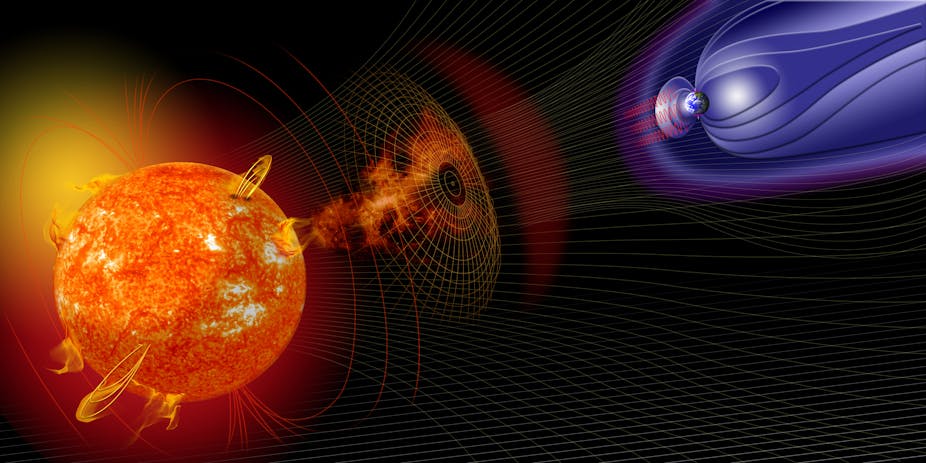We’ve all been caught out by a thunderstorm or freezing winter morning down on planet Earth, but up in space things are rather different. Fluctuations in the weather up there won’t make you cold or damp, but they could end up crippling much of our technology.
The UK government recognises this worry: “severe space weather” was added to the most recent National Risk Register for Civil Emergencies alongside flu pandemics, volcanoes and floods. Now the Met Office has opened a Space Weather Operations Centre in Exeter.
But what is this “space weather” anyway, and why does it matter so much?
So-called space weather storms occur when radiation from the Sun disturbs the Earth’s magnetic field and the upper extremes of the atmosphere, a region known as the ionosphere. Such storms happen when solar flares suddenly release flashes of electromagnetic radiation or when explosions on the Sun called coronal mass ejections release charged particles, which interact with and perturb the Earth’s magnetic field and the ionosphere. This space weather in the ionosphere creates what most of us know as the Northern Lights.
At present relatively little is understood about the likelihood of a huge space weather storm happening soon. We know there have been such storms in the past however, most famously the Carrington Event of 1859 which disrupted telegraph systems across Europe and North America. In those days, electronic communication was relatively new and rare. Today we have very different technology that supports our everyday lives. As society has advanced, so it has become far more vulnerable to the effects of space weather storms.
Solar storms can induce current surges strong enough to knock out power supplies, as happened in 1989 when a solar storm cut power to millions of people in Quebec for nine hours. Satellite navigation systems including GPS would also be hit, with limited availability and reduced accuracy. Think of all the core services that now rely on GPS for navigation or timing: the national grid, internet banking, mobile phones, TV, aircraft landing systems and so on. As a result, understanding the impact of large solar storms on GPS accuracy is increasingly essential.
Storm warning

Researchers at the University of Bath’s Invert Centre for Imaging Science have figured out a way to warn of the effects on the ionosphere from natural solar events and correct for them. By studying images of the ionosphere during solar storms, we can quantify the effects and correct for GPS errors.
To enable this, the university runs a network of GPS scintillation receivers located from the Arctic to the South Pole, which take 50 GPS measurements per second and provide information about rapid variations in signal strength and timing.
In the polar regions, where the Earth’s geomagnetic field is near-vertical, the upper atmosphere is exposed to solar radiation continuously. Lower latitudes such as the UK are only exposed during the most extreme solar storms. By studying these areas, we can understand the physical interactions underlying the processes disturbing GPS signals.
Using this information, the team has developed an algorithm which gives us real-time imaging of the earth’s ionosphere. This means ionospheric errors can be measured and largely removed, allowing for more accurate GPS timing and real-time positioning.
This is part of the technology the Met Office is now using to provide real-time space weather ionosphere forecasting. The new centre will give us an insight into what the weather is like in space at any given moment and should help address how vulnerable our infrastructure and services are to a rogue solar storm.
Where next? Well, we’re working to help the global satellite and communications industry model space weather effects in a sophisticated commercial GPS simulator. This would mean that GPS receivers can in the future be more robust against space weather.

